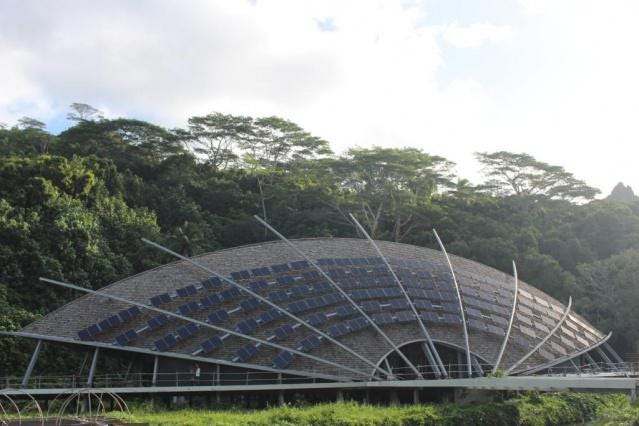
When I was a teenager living in Pakistan, the postman would put the electricity bill of all the residents in the common letterbox near the apartment entrance. And, every month without fail, I would check the bills of every other neighbour to see how we fared in comparison. This was probably a very desi thing to do and to this day I don’t understand what I was really trying to catch. An illegal connection? A bill that didn’t match the number of air-conditioners? Or a small window into a stranger’s life?
Whatever the reason, I won’t be surprised if one of our neighbours would have gone off the grid the moment they learned a teenage girl was spying on their electricity bills. (Side note: I would love to tell you that I outgrew this habit but, let’s just say, I found in journalism a profession that valued my sleuthing skills.)
Perhaps to avoid overly curious neighbours or most likely skyrocketing electricity bills, many people across the world are choosing to live off the grid. So, in this week’s The Global Tiller, we look into what 'living off the grid' means, why are people choosing it and if this is what the future of housing looks like?
When people choose to go off the grid, it is often the electric grid they abandon. They build homes primarily from up-cycled materials, produce their own energy, collect their own water, treat their own sewage and possibly even grow their own food. A curious teenager in this neighbourhood won’t have any bills to investigate.
The largest such community is located in New Mexico, United States, where a man named Michael Reynolds began building Earthships as early as the 1970s. The community, which calls itself the 'Greater World', is striving to achieve carbon-zero living by taking in a lot of human-produced garbage. The United States discards as much as 246 million tyres every day. Compare this to the 1,000 tyres that go into building a single Earthship housing unit and you can prevent a lot of toxins and micro-plastics from going into water supplies. The buildings rely on solar and wind power, have built-in rainwater collection and filtration systems, and include greenhouses that can typically produce 20% to 50% of a resident’s food.
This kind of housing isn’t restricted to the United States. People in many different parts of the world have built Earthships, such as in Germany, Australia and Canada. Some others have developed their own architecture of sustainable living. Here in Tahiti, there are projects underway to build houses with the Super Adobe technique invented by the Iranian-American architect Nader Khalili.
Most of the people drawn into living off the grid are driven by environmental concerns. Some of them were unhappy with the high cost of living on the grid. And then there are those who are anxious about an impending housing shortage. It will come as no surprise then that the Covid-19 pandemic has escalated the demand for Earthships. More and more people are attending training programs to build their own sustainable homes off the grid.
If Earthships and their likes are to become the future of housing, we should ask ourselves where will we find all the land needed to make these houses? Do the environmental benefits of this construction hold as more and more people adopt this lifestyle or will they too suffer the consequences of population density? Some scientists have experimented with Earthships in climates that are different from New Mexico and discovered that back-up heating was required in regions with a heavy cloud cover and rainfall. How does that impact their zero-carbon goal?
Off-grid living is not a simple lifestyle, requiring constant manual labour and care. Are our economies able to cater to this lifestyle choice and what kinds of jobs can it offer? In a way, Earthships are proposing a return to the pre-industrial life. How will that impact human progress and innovation?
If you have had a chance to visit these kinds of houses, do share your experience with us.
Until next week, take care and stay safe.
Hira - Editor - The Global Tiller
What’s up with us
This is our first issue of 2022 and we want to take this opportunity to wish you all a Happy New Year!
Our new year resolution is to grow our community of global citizens and to reach out to others who are as committed to creating an equitable future for all.
If you’d like to join our community, do follow our new social media accounts where we will be sharing updates and resources that shape our thinking. You can find us on Facebook at Pacific Ventury Global and on Twitter @PacificVentury.
…and now what?
There was a time when not eating meat at all was seen as an alternative lifestyle, some kind of New Age thinking adopted by those trying to be original. Since then, veganism has become fairly mainstream: politicians are openly vegan (some doing an almost coming out about it), athletes, movie stars and probably a lot of your neighbours.
Veganism is a signal of change that tells us a tale about the future but also about our present. It tells us where the world could and most probably will be heading but also what are the challenges or issues we’re facing today.
Inspired by traditional diets from different parts of the world, veganism has evolved and has now entered very modern sectors, such as the tech industry where the artificial meat market is becoming a major trend that will continue to develop in the coming years. Definitely something to keep an eye out for in 2022.
Traditions and practices from the past very often come back to us in the present to address challenges of today and help us prepare for the future. It questions if we haven’t gone too far, if we’re heading in the 'right' direction or if we at some point haven’t been as innovative or efficient in the way we progressed as we thought we would.

Is living off the grid one of those new signals of change that, much like veganism, tells us a tale about what the future could look like and what are today’s challenges?
It’s easy to see this imagined future in science-fiction movies where we often see images of scattered villages, deep into forgotten forests, far from the collapsed and ruined city centres in a post-apocalyptic future, made out of scrap and, as we say in French, 'bric et broc' from piles of non-recycled garbage. If we do have a future where energy becomes scarce or too expensive, or if climate change impacts our urban centres, perhaps living off the grid will become the norm.
But that’s for tomorrow.
What does this trend tells us about our present? It tells us that, indeed, we’re wasting a lot that is still useful. But it also tells us that in many ways modern urbanisation has been too uniform in the past decades and it prevented us from adapting to the context, to the climate of the place and be more adaptive to our surroundings.
Are glass buildings a good thing in places where when the sun hits strong eight to 10 hours a day, forcing us to have heavy air-conditioning? Is concrete the most energy-efficient material in climates with large variations in temperature and humidity?
I’m no engineer but it is startling to see how much of the local practices we left behind that were designed for generations to fit the local environment.
As climate change is now a clear reality for everyone, we definitely need to go look at those communities who have decided to build and organise differently. And, unlike what we did for veganism, we should try not to dismiss it too quickly under the 'crazy' label but instead make sure that we get the right questions out of them. Who knows, maybe the way it happened for veganism, we will discover ideas and innovate houses that we will desperately need tomorrow.
Philippe - Founder - Pacific Ventury

